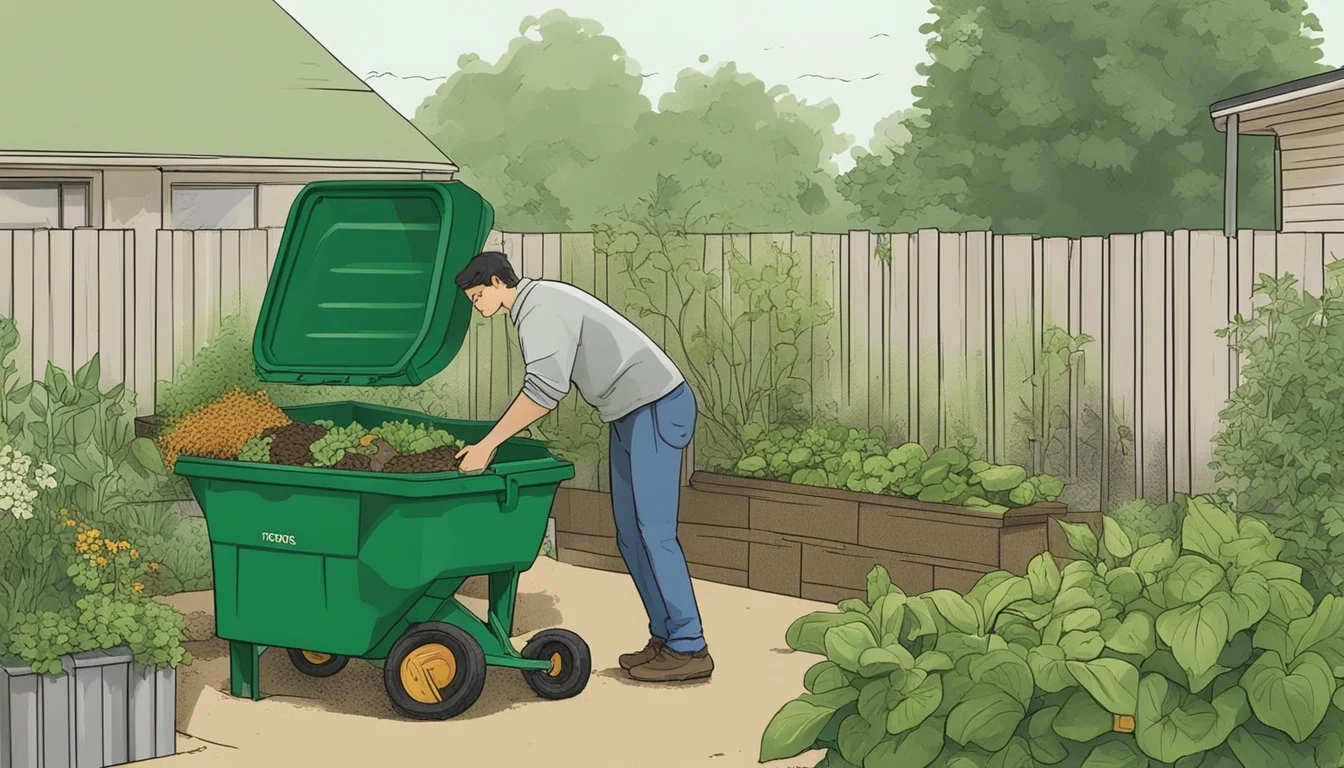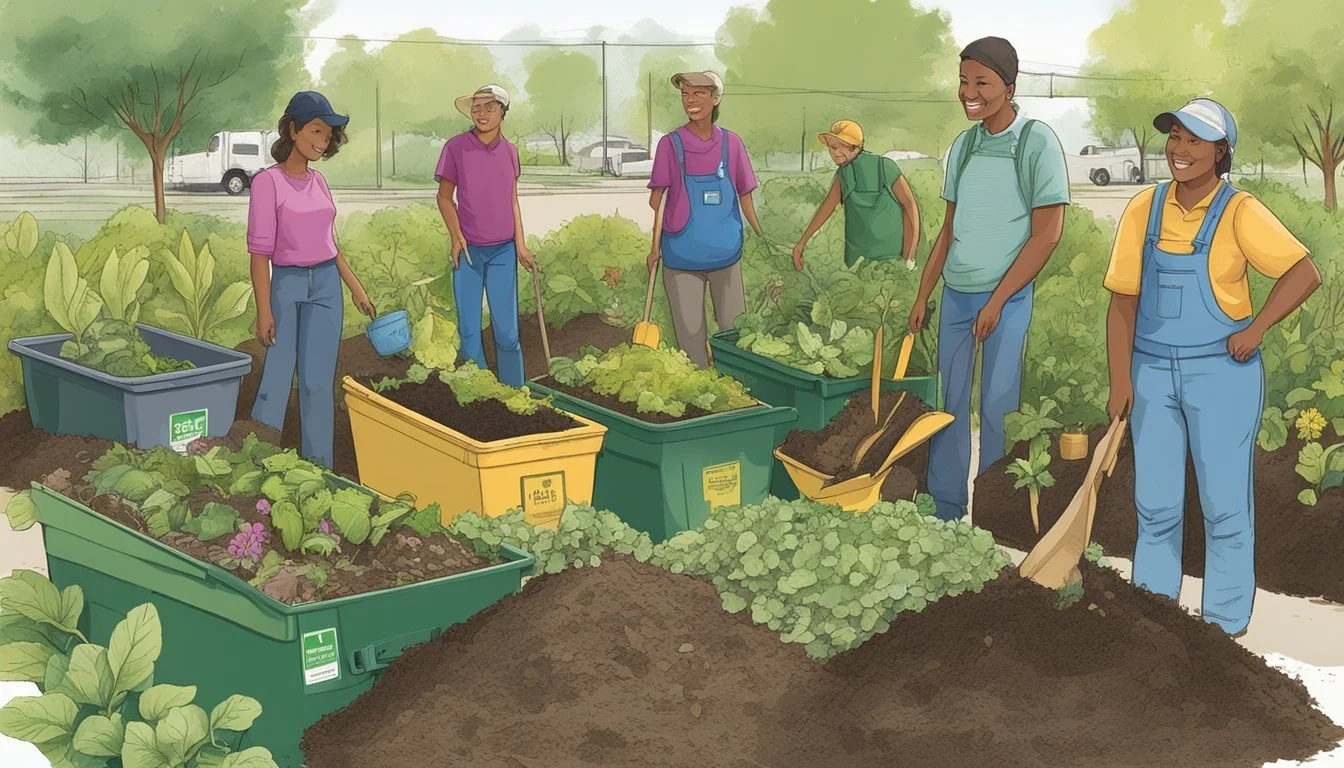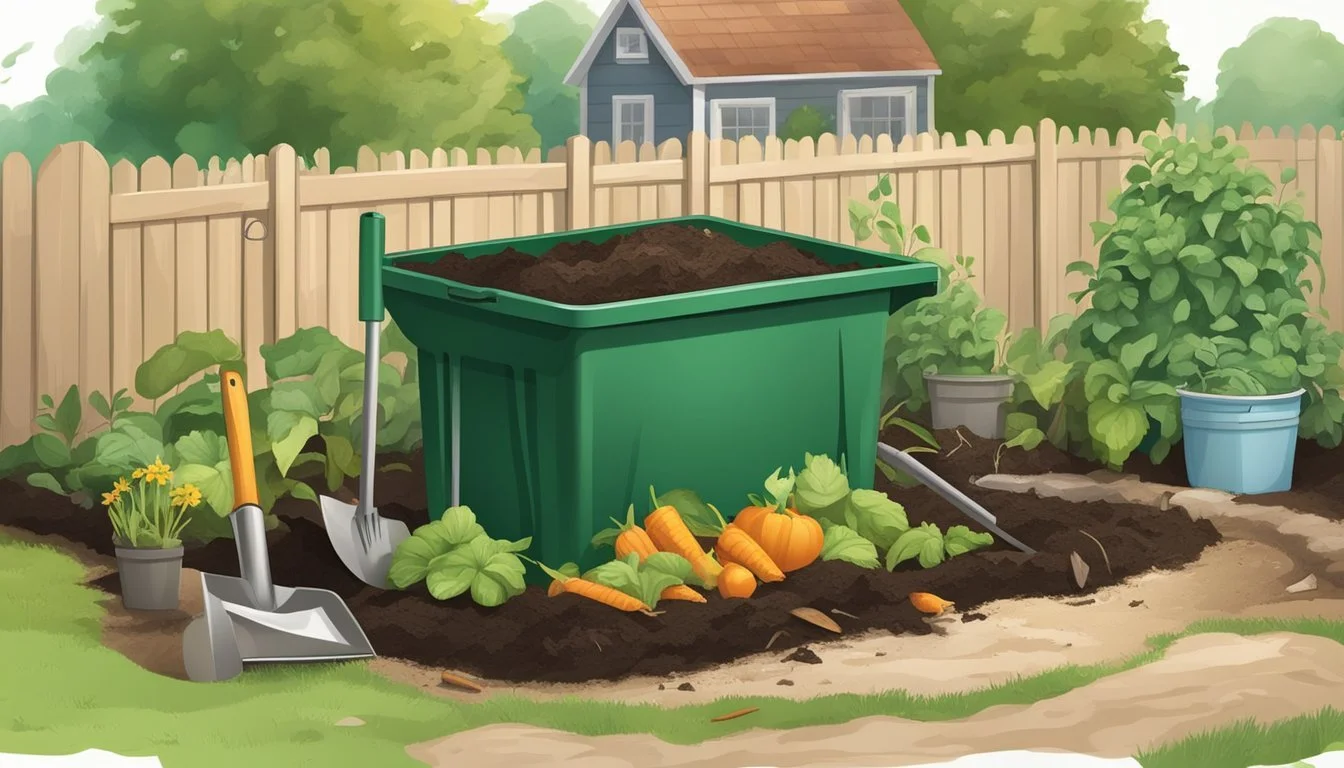Guide to Composting in Fargo, ND
Essential Tips for Local Residents
Composting is an eco-friendly practice widely endorsed by environmental enthusiasts and municipalities alike. In Fargo, North Dakota, the City of Fargo has implemented structures to support and encourage residents to engage in composting activities. Composting not only reduces the amount of waste that ends up in landfills but also transforms organic kitchen and yard waste into valuable, nutrient-rich soil amendment that can be utilized in gardens and landscaping. By doing so, Fargo residents can play an active role in waste reduction and sustainability.
The City of Fargo provides resources and facilities to help its residents participate in composting. With designated composting and yard waste sites, locals have a convenient way to dispose of organic waste such as leaves, grass clippings, and garden debris. These facilities are part of a larger initiative to mitigate the release of methane, a potent greenhouse gas commonly produced when organic matter decomposes in oxygen-deprived landfill environments. The city also promotes backyard composting by educating residents and offering composters for sale, to encourage the process of composting at an individual level.
Composting processes vary, but the end goal is the same: converting organic wastes into a substance that can enrich soil. For those new to composting, the City of Fargo simplifies the process by providing clear guidelines on what can be composted and how. Informed by research and practices on biological decomposition, Fargo's approach ensures that anyone can effectively turn waste into compost, whether through backyard composting or by utilizing municipal services. The resulting compost is not only beneficial for personal use but also contributes positively to the city's overall green initiatives.
Benefits of Composting
Composting in Fargo offers tangible benefits for soil quality, waste management, and the environment. By transforming organic waste into valuable compost, the community can improve garden health and reduce harmful ecological impacts.
Soil Enhancement
Compost adds nutrient-rich humus to garden soil, enriching it and providing a wealth of benefits to plants. A soil amendment like compost improves soil structure, water retention, and aeration. The Fargo composting site enables residents to enrich their soil with compost that is teeming with essential nutrients, promoting stronger plant growth and health.
Waste Reduction
Composting significantly reduces the amount of organic waste that would otherwise contribute to landfill overflow. By recycling yard trimmings and food waste, Fargo mitigates the accumulation of solid waste, effectively diverting substantial waste streams from landfills.
Environmental Impact
Redirecting organic waste from landfills through composting has a positive environmental impact by reducing the release of methane, a potent greenhouse gas. Utilizing compost not only decreases the volume of waste but also contributes to a sustainable cycle of recycling and reusing valuable resources within the community.
Composting Basics
Composting is a method where organic matter such as leaves, grass clippings, and kitchen scraps are broken down into nutrient-rich soil amendments through a process involving microorganisms, heat, and moisture. The resulting compost is beneficial for the garden, providing a natural alternative to chemical fertilizers.
The Composting Process
The composting process is the biological decomposition of organic matter by microorganisms under aerobic conditions. Microorganisms, such as bacteria and fungi, consume organic material, which generates heat and results in a dark, earthy substance. Proper composting also requires adequate water and air to support the microorganisms that break down the material.
Materials for Composting
For successful composting, balance carbon-rich materials (browns) with nitrogen-rich materials (greens). Browns include items like paper, newspaper, twigs, and dried leaves, while greens encompass grass clippings, kitchen scraps, coffee grounds, and eggshells. A general guideline is to use a ratio of three parts browns to one part greens.
Item Type C/N Ratio Leaves Browns High in Carbon Grass Clippings Greens High in Nitrogen Kitchen Scraps Greens High in Nitrogen Newspaper Browns High in Carbon
Maintaining Your Compost Pile
Maintaining your compost pile involves turning it periodically to introduce air and redistribute moisture and heat, ensuring even decomposition. The temperature of the pile should be monitored; a hot pile indicates active decomposition. Moisture levels should be maintained at that of a damp sponge to optimally support the composting organisms.
Choosing the Right Compost Bin
Choosing the right compost bin is essential for efficient composting. The selection depends on the available outdoor space, the volume of yard waste, and personal preferences regarding composting styles and aesthetics.
Types of Compost Bins
Compost bins come in various designs, each suited to different composting needs and preferences. Tumbler bins are ideal for those who prefer a contained system that can be regularly turned, speeding up the composting process. These bins are elevated, which can help deter pests and make it easier to turn the compost.
Stationary bins, on the other hand, are a good choice if you have ample space in your yard. They are typically larger and meant to remain in one spot. While they may take longer to produce compost, they can handle larger volumes of garden waste.
When purchasing, consider the volume of compost you'll need. A standard yard of compost bin should suffice for most small to medium gardens. For larger spaces or more frequent composting, multiple bins or a larger system might be necessary.
Location and Setup
The location of your compost bin is just as important as the type you choose. An ideal spot is level, well-drained, and accessible year-round. Outdoor areas such as a patio or balcony can be suitable for smaller tumbler bins, while a corner of the garden is suitable for a stationary bin.
When setting up your bin, ensure it has contact with the soil; this allows beneficial microbes and worms to enter, promoting the composting cycle. Also, consider the ease of adding materials and the method for harvesting the compost. For the larger yard bins, establish a system for layering garden waste, which may include alternating green and brown materials to accelerate decomposition.
Troubleshooting Common Issues
In the context of backyard composting in Fargo, ND, maintaining a healthy composting system involves managing pests and odors, balancing moisture and heat, and ensuring proper aeration. Mishandling these elements can lead to common composting problems.
Managing Pests and Odors
Effective management of pests and odors is crucial to a successful compost bin or pile. If the compost begins to give off a foul smell, it often indicates an imbalance in the carbon-to-nitrogen ratio or insufficient airflow. For instance, a ratio of 25-30:1 carbon to nitrogen is recommended to minimize unpleasant odors. To deter pests like flies and rodents, kitchen scraps should be covered with a layer of browns, such as dry leaves or shredded paper. Find more detailed instructions on these techniques in Composting Troubleshooting: Common Issues and Solutions.
Balancing Moisture and Heat
Both moisture and heat are pivotal for the breakdown of organic material in a compost pile. The pile should feel like a wrung-out sponge, with enough moisture to support decomposition without becoming waterlogged. During colder months, maintaining a warm enough temperature can be challenging. Layers of insulation, such as bales of straw around the bin, can help retain heat. Conversely, if temperatures are too high, this could be slowing down the decomposition process or killing beneficial microbes.
Maintaining Proper Aeration
Oxygen is the breath of life for a compost pile. Poor aeration can lead to a smelly, anaerobic process. Compost requires regular turning to maintain oxygen levels and speed up the decomposition process. Inadequate aeration is one reason materials might not break down fast enough. Introduce more air by turning the pile or bin weekly, or by using a compost aerator tool. Proper aeration ensures an odor-free composting experience and the creation of rich, fertile compost. Detailed problems with aeration and solutions can be found at Rural Sprout.
Composting in Different Seasons
Composting is a year-round activity that can be optimized by understanding the seasonal changes in Fargo, ND. Each season holds various challenges and opportunities for composing organic matter effectively.
Spring and Summer Composting
In spring and summer, the warm weather and increased sunlight accelerate the composting process. It's the perfect time to add grass clippings and fruit waste, which decompose quickly. Residents can make use of Fargo's composting facilities to dispose of their yard waste during these seasons. The city transforms this waste into a valuable soil amendment, enhancing garden and flowerbed growth. In these warmer months, maintaining a balance of green and brown materials is crucial for effective composting.
Fall Composting Strategies
During fall, Fargo residents can add a significant amount of leaves and other yard waste to their compost bins. These carbon-rich materials balance out the nitrogen-rich waste from the spring and summer. It's also a good time to collect methane for energy production, through the decomposition process at composting facilities. Managing the ratio of green to brown materials is important to maintain the compost's health and ensure efficient decomposition.
Winter Composting Techniques
Winter introduces a unique set of composting challenges due to the freeze-thaw cycles. The cold can slow down the microbial activity, but composting can continue with proper insulation and management. Keeping the compost bin sheltered and adding layers of insulating materials like straw or leaves can help retain heat. Additionally, the Fargo composting program advises residents on how to maintain composting activity throughout the colder months. Regular turning of the compost pile and monitoring moisture levels can counteract the sluggish decomposition process during winter.
Community and Government Initiatives
Fargo, ND, showcases a collaborative effort between residents, local governments, and educational programs to advance composting practices. Key initiatives include public collection points, educational efforts, and access to composting.
Public Collection and Drop Sites
In Fargo, residents have access to various recycling drop sites managed by the City of Fargo. These sites are specifically designed for the collection of yard waste, including leaves, grass clippings, and garden waste. This initiative is jointly supported by surrounding areas such as West Fargo, Cass and Clay counties, Moorhead, and Dilworth. Waste collected at these sites is then recycled into compost. The City of Fargo Compost & Yard Waste webpage details collection area locations and hours of operation.
Educational Resources and Workshops
To increase awareness and participation, the City of Fargo provides educational resources and workshops on composting. These educational efforts, often in collaboration with organizations like River Keepers and Moorhead Community Education, help residents understand the environmental benefits and the practical aspects of composting. Information about composting basics and advanced techniques can be found in the Blueprint Developed by the Cass Clay Food Systems Initiative, which serves as a comprehensive guide.
Access to Composting Sites
The Government of Fargo promotes composting by offering residents not only education but also practical means to compost. There is one compost site near the Fargo Landfill, where residents can bring their yard waste or obtain compost for their own use. During set times in spring and fall, the City of Fargo's recycling program provides city residents one free yard of compost, as mentioned on the City of Fargo Compost page. This initiative reduces landfill waste and encourages the production of healthy soil amendments for gardens and flowerbeds.
Advanced Composting Techniques
Exploring advanced composting techniques enhances the efficiency and outcomes of composting projects. From leveraging worms in vermicomposting to mastering bokashi's fermentation process, these methods provide varied ways for individuals and large operations in Fargo to enrich soil and manage organic waste.
Vermicomposting Essentials
Vermicomposting is an efficient composting method that employs red wiggler worms to decompose organic matter. The worms are put in a bin with bedding material and added food scraps. Over time, they produce nutrient-rich castings, which are an excellent amendment for soil. Essential factors include maintaining appropriate moisture levels, temperature, and avoiding overfeeding.
Materials: Bedding (newspaper, cardboard), red wigglers, food scraps
Conditions to monitor: Moisture, pH, temperature, ventilation
Output: Worm castings and leachate
Large-Scale Composting Operations
For a facility managing large volumes of organic waste, advanced techniques involve bioreactors or windrow composting. These systems can handle greater quantities of waste and require strict monitoring of environmental conditions. They operate through aerobic or anaerobic digestion, producing compost on a larger scale that benefits agricultural and landscaping applications.
Aerobic Systems: Windrows, aerated static piles
Anaerobic Systems: Anaerobic digesters, covered lagoon systems
Considerations: Oxygen levels, temperature control, turnover frequency
Bokashi Methodology
Bokashi composting is an anaerobic process which ferments waste rather than decomposing it. This method uses a specific inoculant impregnated onto bran to pickle the waste, including items not typically compostable through other methods. The bokashi process is odorless and quick, taking about two weeks to complete, and can be done on a small scale indoors.
Ingredients: Organic waste, bokashi bran (inoculant)
Process: Layer waste with bokashi bran in sealed containers
Post-Process: Bury the fermented waste to finish decomposition
End Use of Compost
Once created, compost becomes a valuable resource for Fargo's residents, transforming garden waste into a nutrient-rich substance that can benefit the local landscape. Its use varies from personal gardening projects to contributing to community sustainability efforts.
Incorporating Compost into Gardening
Gardening enthusiasts often utilize compost as both a mulch and a fertilizer for plants. Compost, teeming with nutrients, acts as a soil amendment that improves its structure and fertility. Gardens can thrive when compost is mixed into the soil or laid on top around the plants. Homeowners in Fargo capitalize on the free compost offered by the city’s recycling program, enriching their soil for a more bountiful harvest.
Donating or Selling Compost
Excess compost can benefit more than just personal gardens; it can be donated or sold to local community gardens or at the market. Donating compost to community gardens helps them flourish, providing a free source of organic material that enriches the garden beds. When sold, it generates revenue for the individuals or organizations that have invested resources in producing this compost. Thus, it becomes a sustainable product contributing to the green economy of Fargo.
Additional Tips for Effective Composting
Successful composting in Fargo, ND, hinges on maintaining a vital balance of waste materials, being mindful of what food scraps to include, and knowing how to use the final product, humus, for enriching soil.
Achieving the Right Balance
To create an effective compost heap, the mixture of browns and greens—the carbon-rich and nitrogen-rich materials, respectively—must be managed properly. Browns refer to waste materials like dry leaves, twigs, and cardboard, which add carbon, while greens include kitchen scraps and grass clippings, which supply nitrogen. The optimal carbon to nitrogen ratio is roughly 30:1. This balance supports the microbial activity necessary for composting.
Safely Composting Food Scraps
When composting food waste, one must be cautious; not all food scraps are equal. Vegetable scraps, eggshells, tea bags, and coffee filters are excellent for composting, as mentioned by the City of Fargo. However, to prevent attracting pests and odors, it is wise to exclude meat, dairy, and oily foods.
Using Finished Compost
The rich, nutrient-dense humus resulting from the composting process is a boon for gardens. Testing soil before applying compost can guide one in how much to use. The finished compost can help improve soil structure, water retention, and nutrient content, making it essential for a healthy garden ecosystem.











